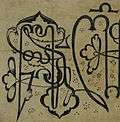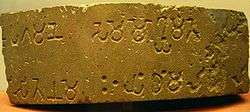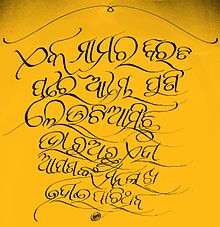Indian calligraphy
 |
| Calligraphy |
|---|
Historical evolution of Indian Calligraphy
Early calligraphy

On the subject of Indian calligraphy, Anderson 2008 writes:
Copper was a favoured material for Indic inscriptions. In the north of India, birch bark was used as a writing surface as early as the 2nd century AD. Many Indic manuscripts were written on palm leaves, even after the Indian languages were put on paper in the 13th century. Both sides of the leaves were used for writing. Long rectangular strips were gathered on top of one another, holes were drilled through all the leaves, and the book was held together by string. Books of this manufacture were common to Southeast Asia. The palm leaf was an excellent surface for penwriting, making possible the delicate lettering used in many of the scripts of southern Asia.
(Note, the birch bark mentioned above is of the Indian Birch, locally called Bhojpatra (patra being leaf/bark/sheet in Sanskrit).)
Middle ages
Indian traders, colonists, military adventurers, Buddhist monks and missionaries brought the Indic script to the countries of South East Asia.

The languages of these regions were influenced by Indic language and culture; the influence came in the form of the basic internal structure, the arrangement and construction of syllabic units, manner of representation of characters, and the direction of writing (left to right) (Gaur 2000: 98). Fine Sanskrit calligraphy, written on palm-leaf manuscripts was transported to various parts of South East Asia, including Bali (Ver Berkmoes ?: 45).It is hypothesized that Persian influence in Indian calligraphy gave rise to a unique and influential blend in Indian calligraphy (although a number of different calligraphic traditions existed in India) and that Indian scripts were fundamentally different from scripts used in Arabic and Persian traditions. The notable achievements of the Mughals included some of their fine manuscripts; usually autobiographies and chronicles of the noble class, these manuscripts were initially written in flowing Persian script.This style of wrtting is very important to india
From the 16th century onwards Sikhism played a key role in the history of Indian calligraphy. Sikhs have traditionally handwritten their holy book, the Guru Granth Sahib, and furnished it with illumination. Sikh calligrapher Pratap Singh Giani (1855–1920) is known for one of the first definitive translations of Sikh scriptures into English.
Features of Indian calligraphy

Religious texts are the most frequent vehicle for calligraphy in India. Monastic Buddhist communities had members trained in calligraphy and having shared responsibility for duplicating sacred scriptures (Renard 1999: 23-4). Jaina traders incorporated illustrated manuscripts celebrating Jaina saints. These manuscripts were produced using inexpensive material with fine calligraphy (Mitter 2001: 100).

See also
Sources
- Salomon, Richard. Indian Epigraphy : A guide to the study of inscriptions in Sanskrit, Prakrit, and other Indo-aryan languages. New York, Oxford University Press : 1999.
- Stevens, John . Sacred Calligraphy of the East. Boston, Shambala : 1995.
- Anderson, D. M. (2008), Indic calligraphy, Encyclopædia Britannica 2008.
External links
- Devanagari script on Omniglot. This site also has information on a range of Indian scripts.
- Scripts and Languages of India